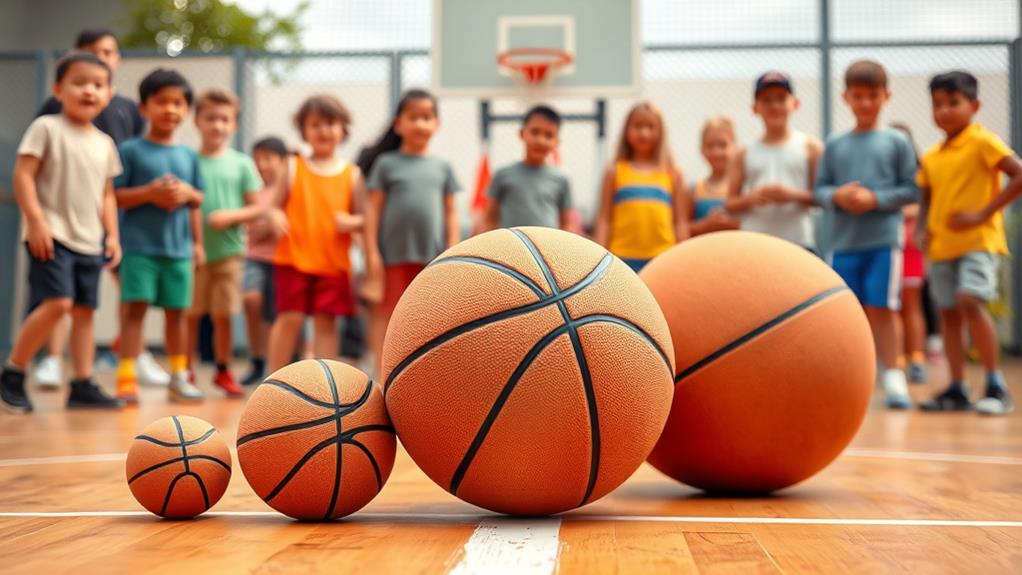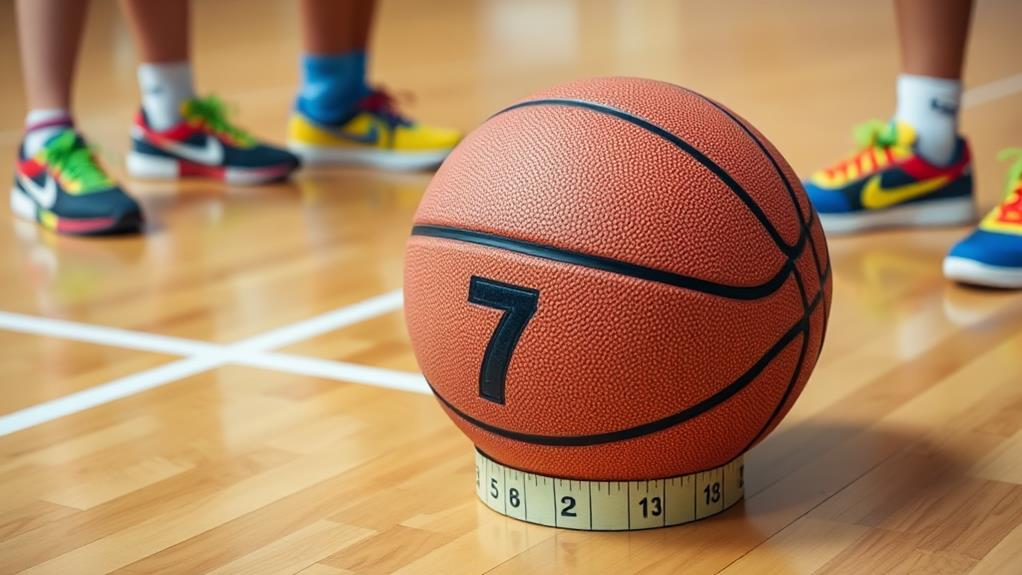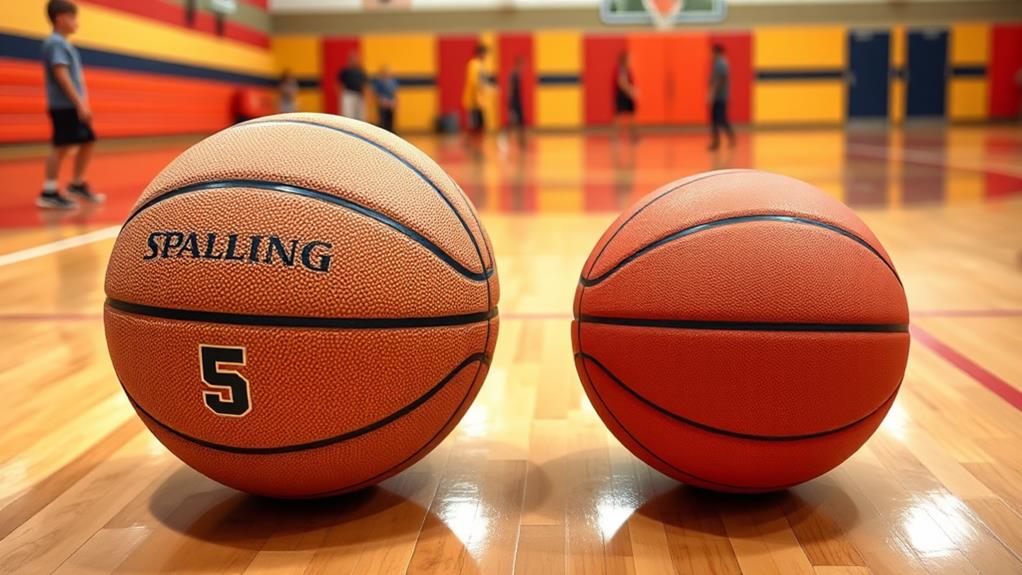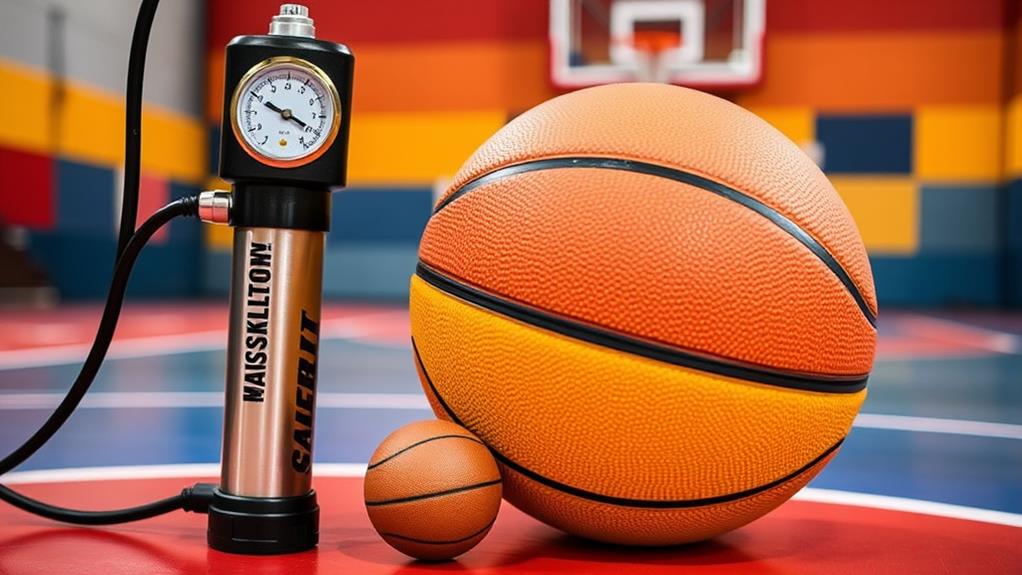
A Guide to Choosing the Right Basketball Size for Youth Players
October 5, 2024Choosing the right basketball size is essential for youth players to enhance their skills and enjoy the game. For ages 4 and under, use Size 3 (22.5 inches); for ages 8-11, Size 5 (27.5 inches) is best to develop fundamental skills. As players grow, switch to Size 6 (28.5 inches) for ages 12-13, and Size 7 (29.5 inches) for those 14 and up, supporting ongoing development. Using the appropriate size improves grip, control, and reduces injury risk. Understanding these details can boost confidence and performance—stick around to discover more valuable insights!
Importance of Selecting the Right Size
Selecting the right basketball size is vital for young players, as it directly impacts their grip, control, and overall performance on the court. When youth players use a basketball that fits their hand span and strength, they develop fundamental skills more effectively. For instance, a Size 5 basketball is perfect for players aged 9-11, measuring 27.5 inches in circumference.
Using the correct size helps prevent the development of bad habits and injuries, as oversized basketballs can disrupt proper shooting and dribbling techniques. Additionally, just as centers have evolved to enhance team dynamics with their versatile skill sets, young players must also adjust their fundamentals to maximize their growth in the game.
modern basketball strategies can greatly influence how they approach skill development.
As players grow older, shifting to Size 6 for ages 12-13 and Size 7 for those 14 and up is essential. This progression supports skill development and prepares them for competitive play. Familiarity with league regulations regarding basketball sizes guarantees that young athletes practice and play with equipment that aligns with official standards.
This not only boosts their confidence but also enhances their skills on the court.
In short, choosing the right basketball size isn't just about comfort—it's about maximizing a young player's potential and enjoyment of the game. Prioritizing the right size allows for better grip, improved control, and ultimately, a stronger performance.
Overview of Basketball Sizes
When it comes to basketball sizes, understanding the variations is key. Each size is tailored for specific age groups and genders, guaranteeing young players can develop their skills effectively.
Data-driven strategies are essential for selecting the right equipment as they can enhance performance and guarantee proper development.
Let's break down the age-specific recommendations so you can choose the right ball for your player.
Size Variations Explained
Basketball sizes vary greatly, and knowing the right one for your youth player is vital for their development. Understanding size variations helps guarantee that players use the appropriate ball, enhancing grip, control, and overall skill development in youth basketball.
Here's a quick breakdown of basketball sizes for youth:
- Size 5 basketball: With a circumference of 27.5 inches, this size is ideal for youth players aged 8-9 and is commonly used in youth leagues to promote proper technique.
- Size 6 basketballs: Measuring 28.5 inches, these are designed for female players aged 9 and up, as well as males aged 9-12, making them suitable for various competitions.
- Size 7 basketballs: The standard size for male players aged 12 years and older, these measure 29.5 inches and are primarily used in professional leagues.
Choosing the right basketball size for youth not only supports their growth in the sport but also boosts their confidence and enjoyment.
Age-Specific Recommendations
Understanding the appropriate basketball size for each age group can greatly impact a player's development and enjoyment of the game.
For youth players aged 8 and under, a Size 5 basketball (27.5 inches in circumference) is recommended, as it caters to their smaller hands and supports skill development. As players progress from ages 9 to 11, sticking with the Size 5 basketball helps them refine their techniques effectively.
Once boys reach ages 12 to 13, it's time to switch to a Size 6 basketball (28.5 inches in circumference). This change helps them hone their shooting and dribbling skills.
Girls aged 12 and up should also use a Size 6 basketball, aligning with women's professional standards in leagues like the WNBA.
For boys aged 14 and up, a Size 7 basketball (29.5 inches in circumference) is appropriate as they prepare for high-level competition. This size accommodates their increased strength and skill level.
Specifications for Size 7 Basketball

When you're selecting a basketball for older youth players, the Size 7 ball is the go-to choice. Measuring 29.5 inches in circumference and weighing 22 ounces, it's the official size used in leagues like the NBA and high school competitions.
This specification aligns with the global standards seen in international tournaments, which showcase top-tier talent from diverse nations.
Understanding its specifications will help you guarantee your player is equipped for success on the court.
Size and Weight Details
Selecting the right basketball size is essential for youth players aiming to develop their skills effectively. When it comes to Size 7 basketballs, you'll find that they're the standard size used in various competitive leagues. This size measures 29.5 inches in circumference and weighs 22 ounces, making it suitable for players aged 15 and up.
Here are a few key details to keep in mind when choosing a Size 7 basketball:
- Standard Size: The Size 7 basketball is the official ball for youth leagues, including NBA and college basketball.
- Weight Consideration: At 22 ounces, this weight is designed for excellent handling, allowing players to improve their techniques.
- Playing Environment: Size 7 basketballs are suited for both training sessions and competitive play, making them versatile for skill development.
Usage Across Leagues
Size 7 basketballs are the go-to choice across various leagues, guaranteeing consistency in play at competitive levels. With a circumference of 29.5 inches and a weight of 22 ounces, this size is officially used in NBA, men's college basketball, high school, and competitive travel leagues.
When you're choosing the right size basketball for your game, it's important to grasp who it's designed for. Typically, players aged 15 and older, who've developed strength and skill, will benefit most from Size 7.
For youth leagues for players younger than 15, it's vital to take into account their hand size and strength. Players with smaller hands may struggle with a Size 7, so it's important to evaluate their comfort and control when playing.
Familiarity with Size 7 specifications not only guarantees compliance with league regulations but also helps players improve their skills effectively. Whether you're shopping at local retailers or online, you'll find Size 7 basketballs widely available, accommodating the needs of competitive male players across different basketball leagues.
Specifications for Size 6 Basketball
Choosing the right basketball can make a significant difference in a young player's development. The Size 6 basketball is specifically designed for players aged 9 and up, particularly those between 12 to 13 years old. Measuring 28.5 inches in circumference and weighing a standard 20 ounces, these size 6 balls cater to younger athletes with smaller hand spans. This guarantees they can handle the ball effectively while refining their skills.
Additionally, just as with soccer, proper equipment plays a vital role in player safety and performance, as highlighted by the importance of player conduct and team composition.
Here are some key specifications of the Size 6 basketball:
- Usage in Professional Leagues: Officially used in women's professional basketball associations like the WNBA and FIBA 3×3 competitions.
- Skill Development: Designed to enhance grip and control, helping young players improve their shooting and dribbling techniques.
- Recommended for Youth Leagues: Many leagues promote Size 6 balls to guarantee consistency in gameplay and skill development within the age group.
Choosing the right size not only supports skill refinement but also makes playing for fun more enjoyable. By opting for a Size 6 basketball, you're setting the stage for success as your young player continues to grow in the sport.
Specifications for Size 5 and Size 3

When it comes to youth basketball, understanding the specifications of the Size 5 and Size 3 basketballs can greatly enhance a young player's experience. The YMCA's emphasis on teamwork and skill development aligns with choosing the right basketball size, as it guarantees that young athletes can effectively practice their shooting and dribbling techniques.
Size 5 basketballs, measuring 27.5 inches in circumference and weighing between 14 to 16 ounces, are perfect for youth players aged 8 to 11. This is the official size used in youth leagues, and it helps promote proper shooting and dribbling techniques, vital for developing players.
On the other hand, Size 3 basketballs are designed specifically for younger children, particularly those aged 4 and under. With a circumference of 22.5 inches and a weight of just 10 ounces, these balls are tailored for small hands, making them easier to grip and handle.
Both Size 5 and Size 3 basketballs aim to enhance early skills in young players, fostering a love for the game from a young age. While Size 5 basketballs are the most popular choice for youth leagues, Size 3 basketballs can serve as fun mini basketballs or commemorative gifts, providing an enjoyable introduction to the sport.
Choosing the right size is essential for nurturing talent and confidence in young athletes.
Indoor Vs Outdoor Basketball Choices
Understanding the right basketball size is just the beginning; the type of basketball you use based on where you'll be playing also greatly affects your game. When you're deciding between indoor and outdoor basketballs, consider the playing surface and the specific conditions of your environment. Proper fit and material choice can enhance gameplay, much like the importance of choosing the right soccer cleats for performance.
- Indoor basketballs: Designed for polished wood courts, they feature softer materials that enhance grip and playability without damaging the surface.
- Outdoor basketballs: Made from durable rubber or composite materials, these balls can withstand rough, abrasive surfaces, making them perfect for outdoor courts.
- Indoor/Outdoor options: These versatile basketballs allow you to use the same ball for both settings without sacrificing performance.
Choosing the right basketball type is essential not just for your game, but also for extending the life of your ball. Indoor balls may wear out quickly if used outside, while outdoor basketballs mightn't perform as well indoors.
For youth leagues, selecting the appropriate ball guarantees better performance and value, allowing young players to develop their skills effectively on any court. Always keep the playing surface in mind when making your choice!
Proper Inflation Techniques

Properly inflating your basketball is vital for peak performance on the court. For youth basketball, knowing the recommended inflation pressure—typically between 8 psi and 12 psi—based on the size and weight of the ball is essential.
Durability and construction quality play a significant role in how well a basketball performs, so always check the specific inflation pressure indicated on your basketball to prevent over-inflation, which can damage the ball and void any warranty.
Before you insert the needle into the valve, moisten it with a small amount of water to protect the valve. Inflate the basketball gradually, and be sure to monitor the pressure with a gauge for accuracy. This step is key to avoiding deformation or rupture, which can negatively impact your playing style.
After you've inflated the ball, let it sit for a few minutes. This allows the air to settle properly, guaranteeing peak performance.
Finally, recheck the pressure before use. By following these proper inflation techniques, you'll make certain your basketball is ready for action, enhancing your youth basketball experience on the court.
Enhancing Youth Player Performance
Choosing the right basketball size is vital for enhancing youth player performance on the court. When you select the correct size, you're not just improving their game; you're helping them master essential skills.
For instance, using a Size 5 basketball for ages 9-11 (27.5 inches) provides better grip and control, allowing for improved shooting and dribbling techniques. Additionally, understanding basic rules and structure of basketball can greatly contribute to a player's development.
Shifting to a Size 6 (28.5 inches) for boys ages 12 and up helps refine their skills while aligning with official standards.
Here's how choosing the best basketball can enhance your game:
- Injury Prevention: Proper sizing minimizes strain on young players' hands and arms, allowing them to practice effectively.
- Skill Development: The right size helps build confidence and establishes a solid foundation for future success.
- Fun Introduction: A Size 3 basketball (22.5 inches) for children aged 4 and under promotes early skill development in a fun way.
With a basketball weighing 20 oz, you're ensuring peak performance while playing on a polished court.
Conclusion
In choosing the right basketball size, you're not just picking a ball; you're paving the way for your young athlete's success. Think of it like finding the perfect pair of shoes—when they fit just right, it's like gliding on air. A well-sized basketball boosts confidence and performance, allowing players to shine on the court. So, grab that size 5 or 6 ball, and watch them dribble their way to greatness, just like legends of the game.


